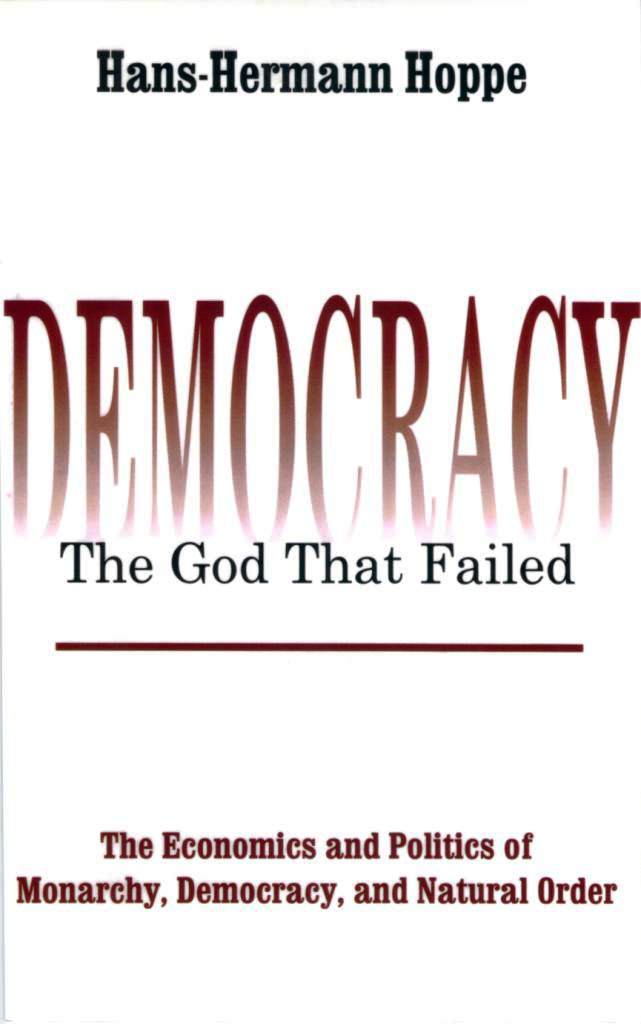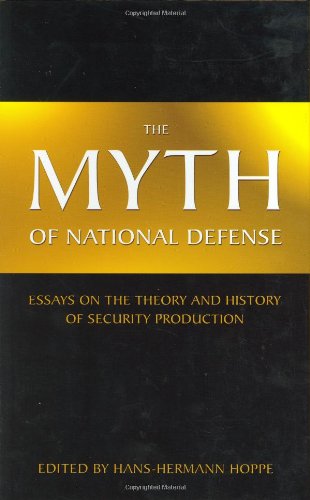Professor Hoppe has published an English-language version of his Preface to the new Turkish translation of A Theory of Socialism and Capitalism. It is reproduced below.
Parts of the Turkish translation are also online: “Mülkiyet, Mukavele, Saldırganlık, Kapitalizm, Sosyalizm” (“Part 2: Property, Contract, Aggression, Capitalism, Socialism”) and “Rus Tipi Sosyalizm” “Part 3: Socialism Russian Style.”
Update:
***
Preface to the Turkish Translation of A Theory of Socialism and Capitalism
Originally published at LewRockwell.com (October 12, 2016)
This book was published first in English more than 25 years ago, in 1989, the same year when the infamous “Berlin Wall” fell and rang in the rapid implosion and dissolution, within only a couple of years, of the former Soviet Union and its Eastern European Empire.
For more than forty years, ever since the “Cold War” had broken out immediately following the end of World War II between the two major former war-Allies – the USA and the USSR (Soviet Russia) –, the post-war European border between a US-dominated “West” and a USSR-dominated “East” that both sides had delineated, and carved out as their victory-prizes in various Allied conferences during the war, had been successively turned into an increasingly impenetrable “iron curtain.” Exit from East to West had become nearly impossible and was threatened with the most severe punishment. In effect, the population of the East had been imprisoned, and the Berlin Wall separating East-Berlin from West-Berlin was the most dramatic manifestation and symbol of this imprisonment.
In the aftermath of World War II, under the domination of the USSR, the “Socialist Experiment” that had started in 1918 in Soviet Russia was expanded and implemented all across “Eastern Europe”. The private ownership of factors of production was essentially outlawed, their former “capitalist” owners were expropriated, and all ownership control was transferred to the State government. Among much of the Western intelligentsia, the “Socialist Experiment,” first on a smaller and then on a grander scale, had been hailed as a “great” and “noble” one. Famed Keynesian and Nobel-prize economist Paul Samuelson, in his Economics, at the time the most successful and widely used economics textbook in Western academia, had predicted that the “centrally planned” socialist economies of the East, after lagging behind the West for a while owing to their lesser initial endowments, would very soon, in the foreseeable future economically take over and surpass Western living standards. When the Berlin Wall came down, in 1989, and in the wake of the subsequent upheavals all across Eastern Europe, it became apparent to almost anyone what every observant visitor could have noticed long before: that the “Socialist Experiment” was, in fact, a complete failure – and that Paul Samuelson and his “new economics” was a bad hoax. As I describe and explain in chapter 3, on “Russian Style Socialism,” a few decades of socialist “experimentation” had everywhere left behind economic wastelands, ravaged countries, and impoverished and demoralized populations.
The sole purpose of the “iron curtain” encircling all of socialist Eastern Europe was to prevent its most productive and entrepreneurial individuals from leaving the East for the West – in the hope, that this would delay the oncoming socialist bankruptcy.
While the momentous events of 1989 and the following years were almost universally interpreted as a defeat for socialism – and a major setback for the leftist Western intelligentsia – immediately an intellectual battle ensued over the wider, global meaning and interpretation of these events. If it was socialism that had lost, who had won?
The most prominent answer to this question was: The West had won. The West, that was the USA and its Western European and worldwide dominions and dependencies; and since the USA, in world public opinion, was considered the prime example of capitalism, it was capitalism that had won.
In fact, the USA did not represent capitalism but as America’s ascendant neoconservative elites were fond to proclaim, “democratic capitalism” – something quite different and supposedly much better. But the intimate association, in the public mind, of the US with capitalism, false as it was and still is, turned out enormously beneficial for the quick recovery and resurgence of the Western Left from its earlier defeat.
Under democratic capitalism, all private property remained nominally untouched and intact. However, a democratically elected state government could interfere with private property rights if this was deemed in the democratically determined “public interest” and for the “common good.” For this purpose, the government could expropriate, tax and redistribute private property, and it could legislate or regulate the uses that private owners were allowed to make of their property. That is, all property and in particular all property in factors of production (capital) was de facto only provisional private property, i.e., the property remaining in private hands and under private control as a state government grant, to be kept as long as the government deemed this in the “public interest.”
In less than 200 years under this “constitution,” the US-government had not only become the country’s largest land- and real estate owner and owner of all “public” streets and schools. For the “common good” it had grown to annually consume almost half of the US national product (GDP), and the “public debt” had steadily increased to reach 60% of GDP by 1989 (and more than 100% today). In the name of the “common good,” the government had monopolized the production of money, established a government-controlled central bank, abolished the gold standard and replaced gold with a paper-money that it could, with the help of its central bank, create at will at practically zero cost. Through a steadily growing flood of legislation and regulation, the property rights of private owners were constantly redistributed and reshuffled. Some people and businesses were made worse off and others better by the stroke of a pen, and some capitalist fortunes were so lost and others created. “Friends” of government, the promoters of the “common good,” were rewarded and its “enemies” punished. And for the “common good” and to make the world safe for democracy, the US-government maintained the world’s largest, most costly and heavily armed military forces, occupied hundreds of military bases around the globe, and engaged in a seemingly endless series of wars to enlarge its empire and sphere of influence.
If that was capitalism, then there was much and increasingly more to complain and find fault with capitalism. Even more so, since the post-1989 economic development in the US – and similarly in the countries of the Western European Union (EU) that had adopted and followed the US-model most closely – was anything but impressive or promising. Everywhere a large and steadily growing under-class of state-dependent “public welfare” clients had emerged side by side with a small oligarchy of the super-rich, government and central bank connected bankers and financiers – all the while working and middle-class incomes had begun to stagnate or even fall.
But was it really capitalism that was responsible for all this? Or was it democracy? Wasn’t capitalism associated with private property and laissez-faire, i.e., with free choice and exchange based on and within the constraints of private property? Yet how could this be reconciled with the fact that the state government extracted and expanded annually about half of a country’s GDP and monopolized not only the production of the country’s entire infrastructure (of roads, schools, public buildings and lands) but in particular also the production of money and credit? On the other hand: Wasn’t democracy, i.e., majority rule, incompatible with private property and laissez-faire? Wasn’t democracy just another, a particular form of socialism, i.e., of the “socialization” of the means of production? And wasn’t it democracy that had to be blamed for the increasingly blatant shortcomings, failings, and blunders of the US and the Western world?
However, no one it seemed suggested this latter possibility. Democracy had become a tabooin the West, an indisputable and unquestionable ‘given’ and ‘good.’ Instead, all blame, for every apparent “wrong,” was laid at the feet of capitalism. And it was, in particular, the leftist Western intelligentsia and academia, safely installed in government licensed and financed universities and schools, that most eagerly protected and promoted this intellectual taboo.
In fact, many Western socialists had already recognized long before the Soviet revolution in Russia, in 1918, that democracy was a fundamentally socialist idea; that “democratic capitalism” was a contradiction in terms; that democracy actually meant democratic socialism; that democratic socialism, almost by definition, was a more popular variant of socialism than the one-party-rule socialism of the Soviet-dominated East; and hence, that democracy was the safest and least resisted method for the attainment of their egalitarian socialist ends. Accordingly, in response to every economic or social “problem,” “scandal” or “crisis,” real or imagined, attributed to “capitalism”, the Western Left resounded with a call to still more democracy, i.e., even more, far-reaching state interference with existing private property rights.
While private property was not abolished entirely in one stroke and given over to government control as in Russian Style Socialism, in the US-dominated West, under the influence of democratic socialism, the encroachment on private property rights by the state proceeded gradually, step by step, but relentlessly – until today, when no part and aspect of human life, from birth until death, whether as a consumer, producer or trader, at home, at work or in “public,” is left free and unregulated, and all of the private property and private property rights have become a farce – with the already indicated dire results. The economic decline of the West occurred more slowly and was less dramatic than that experienced in the East, and hence democratic socialism has outlasted one-party socialism by some decades. But just as the ultimate economic breakdown of Soviet socialism could have been safely predicted long before it actually occurred, so already now can the oncoming economic bankruptcy and social upheavals of Western democratic socialism be predicted. Democratic socialism – the Western economic system – has entered its end game and is bound to break down, somewhat later than its Soviet socialist cousin but just as surely.
Without a doubt, the Left will try to label also the coming economic breakdown and social disaster as a – indeed: the “ultimate” – “crisis of capitalism” and propose to “cure” it with yet another version of socialism. However, as the following book will explain, no variety of socialism can ever produce lasting peace and prosperity. Only capitalism can achieve this. Yet capitalism is something entirely different from what its socialist detractors say it is. Capitalism means justly acquired private property and free, voluntary association, contract, and exchange of and between the owners of private property. Capitalism so conceived is nowhere to be found in the contemporary world. It remains an unrealized ideal. At certain times and places, societies made significant advances toward this ideal and accordingly prospered and flourished. However, the steadily growing influence and seemingly unstoppable popularity of socialist ideas from the mid-19th century onward put a tragic end to any such attempt and has derailed and reversed any such tendency.
It is one central purpose of this book, then, to explain these socialist ideas, however, popular and influential they are today, as fundamental ethical and economic errors, with grave moral and economic consequences, and to explain and promote instead the ideal of capitalism as both a morally just and a prosperous social order.











